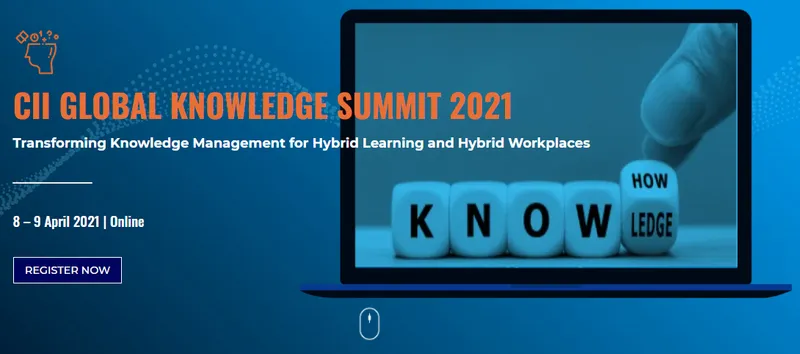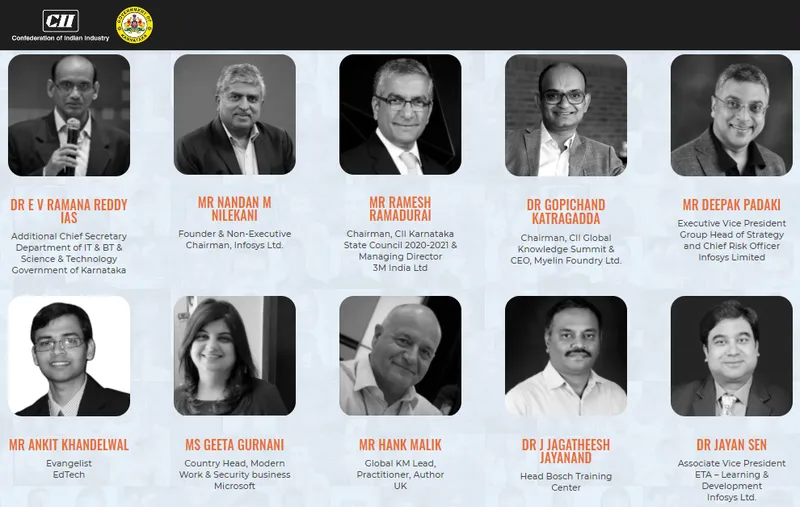Design thinking is core for employee and customer engagement – CII Knowledge Summit addresses resilient mindsets of the future
In this preview article on CII’s upcoming global summit, two experts share examples and experiences of design thinking in action.
CII’s annual Global Knowledge Summit is being held entirely online on April 8-9 this week. The theme of the 16th summit is Transforming Knowledge Management for Hybrid Learning and Hybrid Workplaces.
As media partner for the Knowledge Summits, see YourStory’s coverage of the editions from 2021, 2020 and 2019, and sessions takeaways from the Bangalore K-Community meetups. See also our d.Zen (‘Design Zen’) section with more resources on design thinking.
YourStory has published profiles of MIKE (Most Innovative Knowledge Enterprise) award winners EY, Tata Steel, Cognizant Technology Solutions, Afcons Infrastructure, Petroleum Development Oman, BINUS University, and Mobarakeh Steel Company.
The pandemic era
Two experts share their hard-earned insights on the role of design thinking during the pandemic era and beyond. “Before April 2020, we had never conducted a virtual training programme. In March 2021, we conducted over 300,” explains Anirban Bhattacharya, founder of art-based training institute The Painted Sky, in a chat with YourStory.
His team spent much of March and April last year engaging with clients and learners and understanding how their worlds were being impacted by the pandemic. “We interviewed business leaders, L&D folks and employees,” he recalls.
His 11 years of experience in design thinking helped. “We could identify people’s interests, needs, concern, aspirations, and also the physical constraints of space, networks, and infrastructure,” Anirban says.
This led to some very inspiring and innovative ideas that helped prototype and test approaches, tools and mediums for virtual learning very early. “We leveraged technology and collaboration tools very effectively, and could transform many of our programmes quite seamlessly to the virtual learning world,” he proudly says.
Some of the 30+ projects of 2020 included areas like onboarding and candidate experience, employee morale, WFH experience, and employee mental health. “In the customer space, we have worked with ecommerce companies, banks, tech majors, food delivery companies, FMCG companies, and others to help them discover customer experience opportunities during the disruptions,” Anirban adds.
As outstanding results, he points to innovative incentive programmes for employees to work less hours to deliver results, communication and co-creation tools for better collaboration between dispersed employee teams, and efficiency tools that measure emotions through engagements and new products for customers.
“While 2020 was challenging, unprecedented, and at times filled with despair for many, it also gave rise to even more innovative thought with industry leveraging design thinking,” observes Dr Jayan Sen, AVP and Head of Learning & Development at Infosys.
Brands increasingly adopted and traversed the specific stages of design thinking. “These stages included identifying the right problem, ideating and ‘pretotyping’ potential solutions in order to fail fast, testing and iterating,” Jayan adds.
As an example, he cites Infosys Meridian, part of the Infosys Live Enterprise suite, designed for evolution into a remote-first experience. “This was created by a cross-functional group spearheaded by the learning team (ETA), who conducted a series of design thinking sessions in collaboration with multiple groups,” he describes.
Clients who leveraged the platform externally included the Australian Open. “Meridian helped Infosys to significantly reduce the event costs by approximately 60 percent, and lead time in conducting virtual events by almost 70 percent, compared to market-leading virtual events platforms,” Jayan says.
As other examples of design thinking in action, he cites Marks & Spencer’s payment app, online sales, home delivery, and set up of COVID testing sites. “A Brazilian airline also projected seat numbers for the boarding plane onto the ground, which allowed travelers in queue to board more safely, quickly and according to their seat allocation,” he describes.
Bigbasket is another good example in India, with its collaboration with FMCG companies, human resource agencies, cab aggregators, and other players to honour customer commitments. “They understood and applied iterative design principles,” Jayan observes.
“Bigbasket partnered with Uber for deliveries, embraced non-conventional forms of hiring to keep up with demand, leveraged the expertise of its investment partner Alibaba, expanded its range through inorganic means, and engaged in sensitisation drives,” Jayan adds.

A culture of design thinking
Embracing design thinking as a way of work calls for involvement beyond one-off workshops and training, as the speakers reveal.
“Design thinking is a way of thinking, behaving, and working. In addition to being a mindset, it embraces a set of values. An active design thinking mindset needs elements of humility and integrity to get optimal results,” Jayan of Infosys explains.
Design thinking can be an underlying rubric of an organisational culture. “It represents a set of behaviours, values, and rituals that can define how organisational citizens do things, and unlock true potential,” he advises.
Organisations need to be willing to embrace failure. “Failure is an initial glimpse of an innovative future. Appreciating the thought and effort while creating a safe space for failure to happen quickly is a cornerstone of design thinking,” Jayan emphasises.
The key is to move on quickly and iteratively get to a better point. “This by itself can set a tone for the culture. Nurturing creative confidence can create an ecosystem of enablement, empowerment and innovation,” he adds.
Much of KM is based on best practices. “But sometimes best practices may not yield the correct problem, much less the most optimal outcome. Design thinking looks for many lenses, and this is possible when employees also do this intermittently rather than going only with the tried and tested approach,” Jayan suggests.
“Collaboration and empathy are elements within a culture that can establish design thinking through a sharing of knowledge and associated learning,” he adds. The right metrics should be in place as well to measure success, which can establish design thinking as integral to the culture and encourage learning.
“Culture, as you know, is driven top down. Design thinking culture is possible, and we have seen it work brilliantly, irrespective of function and domain,” says Anirban of Painted Sky.
For this, five things need to be in place: leadership sponsorship, learner commitment, access to real stakeholders, sustained learning opportunities, and internal brand-building.
“Leaders need to ensure bigger picture alignment and support, open doors, and maintain focus. Learner focus should be kept through links to KRAs and KPIs, to have accountability and sustain commitment,” Anirban explains.
“Access to real stakeholders like users and customers makes the learning meaningful and relevant. Projects with opportunities for application and coaching provide sustained learning. Communication and activities like R&R help build interest and desire for design thinking,” Anirban adds.
His teams have also been KM partners for a number of companies, and here too the above approaches have helped. “We have helped them figure out the best ways in which they can become most relevant and meaningful to their colleagues,” Anirban explains.
These initiatives have started with the core design thinking principles of discovery before design and delivery, he adds. “Knowledge sharing helps understanding. Leaders must avoid confirmation bias and groupthink pitfalls,” he cautions.
Anirban advises leaders not get too enamoured by their own experience and knowledge, and focus on empathising with users instead. “Being human-centered is the key, rather than product, tech or tool-centered,” he emphasises.

The new normal
Anirban of Painted Sky expects design thinking to continue to remain relevant after the pandemic as well, across all domains and functions where there are human stakeholders.
“In many of our consulting projects we are seeing companies apply design thinking to better figure out the post-COVID world. This includes understanding people’s emotional needs, particularly fears and concerns as well as aspirations and joys, about both on-campus and WFH options,” he observes.
More investment is needed to figure out these elements of human behaviours, and develop ways in which the future workplace can be made more conducive for performance.
“I also see design thinking being very relevant for industries, particularly consumer industries, as they try to figure out their customers’ needs and desires as they start going back to earlier, pre-COVID schedules with post-COVID mindsets,” Anirban adds.
This includes how customers interact with tools and spaces, and experience the world. “The solutions may be very different in banking, travel and ride sharing. Managing future flows will require more discovery. Design thinking will be the key,” he affirms.
Cycle times in the new normal will continue to shorten, leading to a growing need for speed of decision making, and agility of delivery while improving overall efficacy. “Technologies that have not existed a few years ago and the nature of data will further raise the tempo of the scope and scale of innovation,” Jayan of Infosys observes.
Rethinking work, reimagining structure, and reshaping talent are paramount for future growth. “To do this, design thinking needs to be a central element of talent management, innovation around business models, operational efficiencies, and new product development,” he advises.
Human-centered design thinking helps link seemingly disparate variables and offers more connected experiences. “It is possible that experiences born out of the current normal could prove inspiring and appropriate even when the pandemic starts to fade,” he adds.

Trends
The two speakers also identify emerging business and ecosystem trends that bode well for the future of design thinking and its continued application.
According to Jayan of Infosys, organisations seeking to embrace design thinking will focus more on empathetic mindsets, active listening, meaningful probing, being comfortable with ambiguity, and the ability to separate convergent from divergent thoughts and ideas.
“While design thinking can help optimise the situation, real gains are made when design thinking is coupled with ‘design linking’. This is where the problem has been solved and then executed with excellence,” Jayan explains.
Another trend he identifies is equity in design. “Diversity, Equity, Access, and Inclusion (DEAI) has seen increased focus globally. In design thinking, this means an ideal and equitable representation of the stakeholders,” he says.
“This results in a solution that is inclusive and focused on not just a vital few, but also representative of the varied many,” Jayan adds.
“I will be most interested to see how design thinking, with its deep focus on human experiences, adapts to the rise of AI,” Anirban of Painted Sky explains.
Most machine tasks so far have been restricted to lower order, repetitive problem solving, which have not needed human creativity, intuition and emotions. “Yet, with the rapid advancements in technology, it will be interesting to see how and if design thinking can impact this,” he suggests.
This will mean design thinkers need to go deeper to understand humans behind and in front of machines – those who make and those who consume. “The former will mean more work on unconscious and cognitive biases of engineers and designers. They, in turn, need to embrace design thinking to understand customers to make their solutions better,” Anirban advises.

Tips and advice
To effectively harness design thinking, Anirban of Painted Sky urges business leaders to listen, experiment, and practice more. “Listen. And observe. And question. Everything. By discovering realties and constantly challenging status quo, leaders can internalise and evangelise design thinking,” he suggests.
“Experiment. Design thinking is an iterative, circular process where we improve constantly by building, testing, learning and building again,” he adds.
The spirit of experimentation is critical. “It makes leaders stop taking their ideas too seriously, develop an appetite for collaborative learning, and also reduce the fear of failure by accepting that everything they make is likely to be improved upon anyway,” Anirban advises.
“Practice, practice, practice. Don’t read books or watch videos only on design thinking – broaden your learning of the context for design thinking instead,” he recommends.
“You cannot learn design thinking without doing design thinking. In the last 11 years, we have coached and trained and consulted for 20,000+ hours in the space. And we have seen most success when leaders have participated actively, learnt and mastered design thinking,” Anirban emphasises.
Leaders must understand that empathy is key to both the process of design thinking and in creating the right cultural ecosystem and employee mindset. “This will help set the tone for innovative ideation and visionary thought with an agile way of failing fast and getting to an optimal outcome with quicker cycle times,” Jayan of Infosys explains.
The road ahead
Design thinking has larger implications for the society as well as business. Its lessons and contributions will mount in the years after the pandemic as well.
“Global ‘Black Swan’ events like the pandemic are also an opportunity to reboot as they move us faster in the evolving chain of change. Design thinking is one of those resources that organisations can use freely as they maneuver and try to harness the opportunities of the new normal,” advises Jayan of Infosys.
“We are big believers in humanity-centered design over human-centered design,” Anirban of Painted Sky explains. Design thinking conversations need to be brought to the centre to address bigger questions of empowerment, ethics and environment.
“The empathy we espouse must cover more than just our core stakeholders, and address the system and others impacted by design and consumption decisions. We need to think in systems, and design for sustainability in everything we do,” Anirban signs off.
Edited by Megha Reddy











